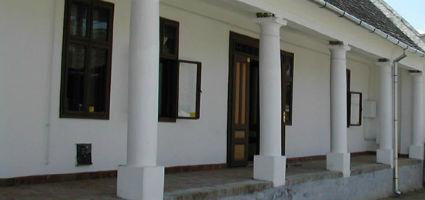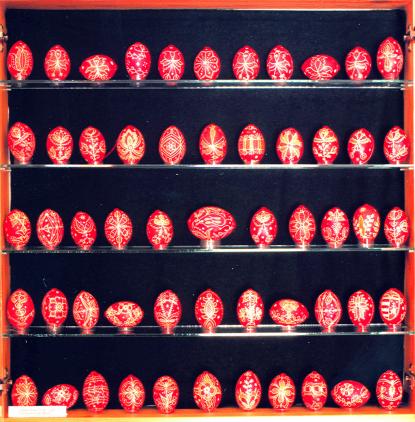2024. April 25. Thursday
Bata Region House - Báta
 |
Address: 7149, Báta Fő u. 86.
Phone number: (74) 490-558, (20) 576-4130
E-mail: batai.tajhaz@gmail.com
Opening hours: Tue 8-12, Thu, Sat 13-17
|
Museum tickets, service costs:
|
Ticket for adults
|
500 HUF
|
|
|
Ticket for children
|
250 HUF
|
The egg is one of the oldest symbols of rebirth and proliferation. This is the most perfect form made by nature. It hides new life and with this, the secret of birth and creation.

It is able to describe the greatness of the universe and the fathomless state of transition from lifeless to life. This is why eggs are given as present ever since the beginning of humanity. "Egg painting is mentioned as a unique branch of ornamental art in Sárköz. It was general among Catholics living in Báta since painted eggs were indispensable company to the "old friend plate" sent over at Easter. Easter eggs in Báta were "written" with wax which meant that more colours could be applied. The first colour to apply was white, the colour of the egg which was preserved by the wax spread all over it. Then, the egg was put into the brew of a yellow flower to colour the egg yellow. Then the egg was covered with wax again and coloured with another colour, usually red. After the egg was covered with wax again, the last, the darkest layer of colour was put on, usually dark-brown or black. The patterns were also very old, similar ones can be found among Hungarian speaking people everywhere. wrote Bertalan Andrásfalvy.
Traditions accompanying Easter eggs were still alive in the 1930's in Báta. At Easter, the godmother gave an Easter egg and four "krajcár" (money) to her grandchild. Children enjoyed throwing a coin into each one of the eggs before eating them. Who succeeded could keep the egg and the coin, Who failed had to give both to the owner of the house.
Another tradition was the sending of a "fiancée plate". The "fiancée plate was a very colourful plate with pretzels at the bottom, a bottle of wine in the middle and painted eggs around it. In its four corners, it was covered with red chief with ribbon pinned on. Girls sent the plate to households with young man and vica versa on the second day of Easter. The messengers related the name of the sender and asked Is it accepted? When the plate was not accepted, it was returned to the sender. When the plate was accepted, the eggs were exchanged for their own painted eggs or either sent it back or sent it on to someone they liked better. Not only had those sent "fiancée plates" who wanted to find new lovers but also those who wanted a spouse. This tradition was almost completely forgotten by the end of the 20th century and along with it egg "writing" too.
Due to the nature of eggs, there are hardly any painted eggs left for us. There may be a dozen at the Baja Museum The eggs were collected by Gábor Lülő under his management. However, old patterns were saved in greater number, on paper, on the side of calendars, drawn on sawn pattern. Mrs. Dér, Aunt Teszka, the master of folk art saved the patters and revived the tradition of egg writing developing it into a valuable folk art. A basket of her Easter eggs were shown at the Brussels's World Fair where they made a hit.
Easter eggs are more like Easter presents nowadays and are product of trade. The meaning of the patters on the eggs is not valued anymore. The colours used originally are added new ones, purple and green to satisfy the customers.
The symbols vary depending on the artist. Still, we can say that there is a kind of unified style of Sárköz. The eggs shown were made by Mrs. Lehel Péter Dr. The Young Master of Folk Art. She applied patterns she collected from old "writing" women.

It is able to describe the greatness of the universe and the fathomless state of transition from lifeless to life. This is why eggs are given as present ever since the beginning of humanity. "Egg painting is mentioned as a unique branch of ornamental art in Sárköz. It was general among Catholics living in Báta since painted eggs were indispensable company to the "old friend plate" sent over at Easter. Easter eggs in Báta were "written" with wax which meant that more colours could be applied. The first colour to apply was white, the colour of the egg which was preserved by the wax spread all over it. Then, the egg was put into the brew of a yellow flower to colour the egg yellow. Then the egg was covered with wax again and coloured with another colour, usually red. After the egg was covered with wax again, the last, the darkest layer of colour was put on, usually dark-brown or black. The patterns were also very old, similar ones can be found among Hungarian speaking people everywhere. wrote Bertalan Andrásfalvy.
Traditions accompanying Easter eggs were still alive in the 1930's in Báta. At Easter, the godmother gave an Easter egg and four "krajcár" (money) to her grandchild. Children enjoyed throwing a coin into each one of the eggs before eating them. Who succeeded could keep the egg and the coin, Who failed had to give both to the owner of the house.
Another tradition was the sending of a "fiancée plate". The "fiancée plate was a very colourful plate with pretzels at the bottom, a bottle of wine in the middle and painted eggs around it. In its four corners, it was covered with red chief with ribbon pinned on. Girls sent the plate to households with young man and vica versa on the second day of Easter. The messengers related the name of the sender and asked Is it accepted? When the plate was not accepted, it was returned to the sender. When the plate was accepted, the eggs were exchanged for their own painted eggs or either sent it back or sent it on to someone they liked better. Not only had those sent "fiancée plates" who wanted to find new lovers but also those who wanted a spouse. This tradition was almost completely forgotten by the end of the 20th century and along with it egg "writing" too.
Due to the nature of eggs, there are hardly any painted eggs left for us. There may be a dozen at the Baja Museum The eggs were collected by Gábor Lülő under his management. However, old patterns were saved in greater number, on paper, on the side of calendars, drawn on sawn pattern. Mrs. Dér, Aunt Teszka, the master of folk art saved the patters and revived the tradition of egg writing developing it into a valuable folk art. A basket of her Easter eggs were shown at the Brussels's World Fair where they made a hit.
Easter eggs are more like Easter presents nowadays and are product of trade. The meaning of the patters on the eggs is not valued anymore. The colours used originally are added new ones, purple and green to satisfy the customers.
The symbols vary depending on the artist. Still, we can say that there is a kind of unified style of Sárköz. The eggs shown were made by Mrs. Lehel Péter Dr. The Young Master of Folk Art. She applied patterns she collected from old "writing" women.
|
Related activities
|
||
